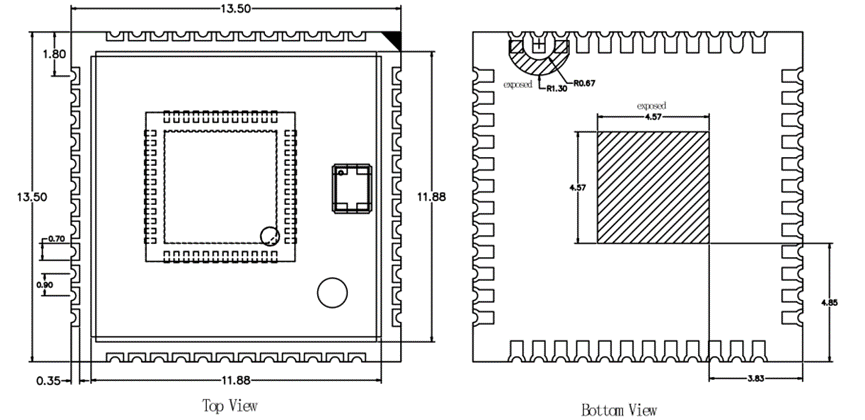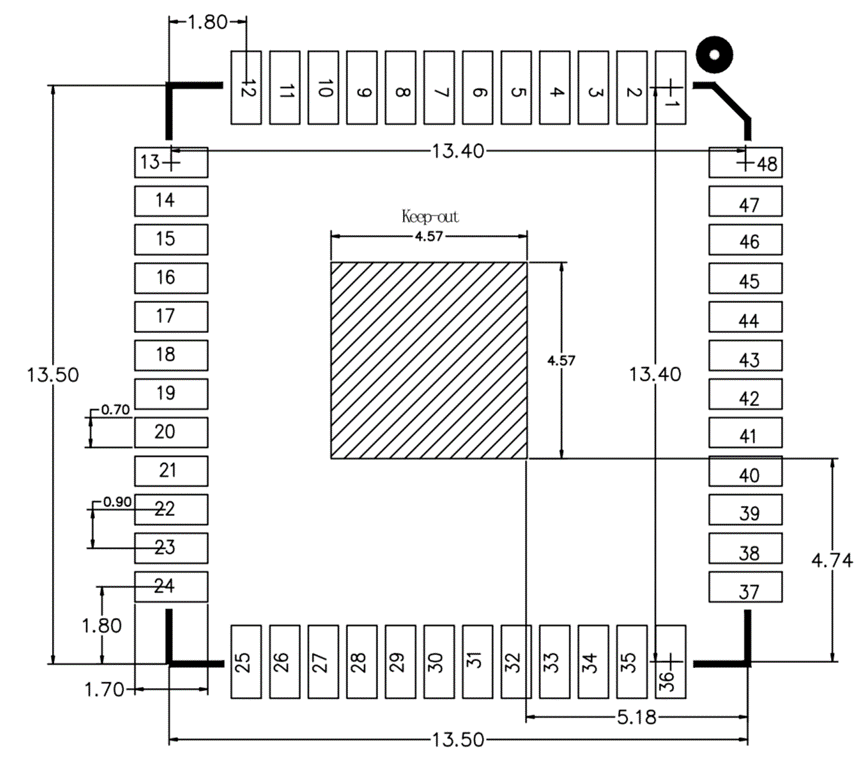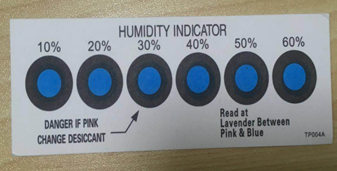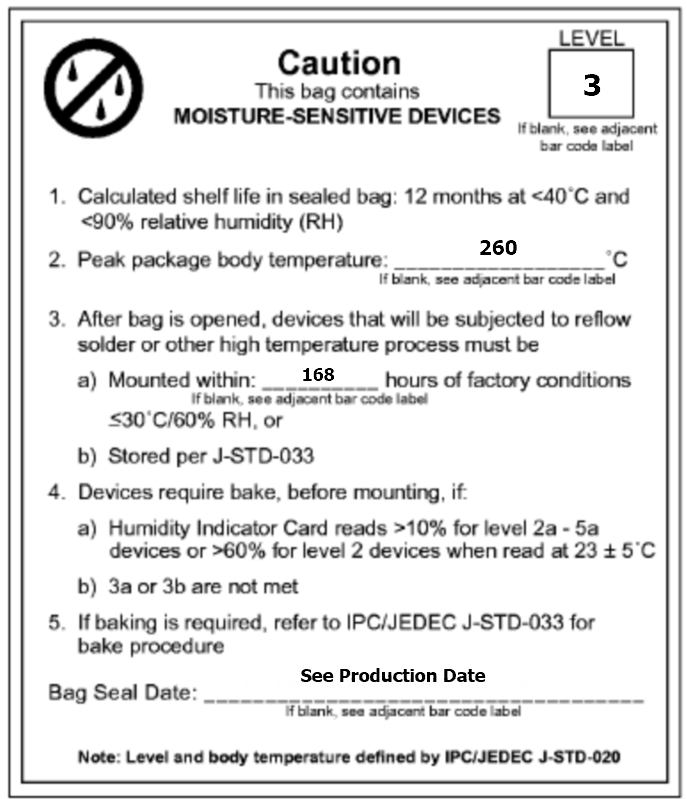TY004 Module Datasheet
Last Updated on : 2025-05-29 06:21:53download
Overview
TY004 module is a Wi-Fi and Bluetooth Low Energy (LE) combo module developed by Tuya Smart for the IoT field. It consists of a highly integrated wireless RF chip RTL8720CS with built-in Wi-Fi stacks and various library functions, and supports Bluetooth LE functionalities. Using ARM Cortex-M0 and M4 dual cores, it has rich peripheral interfaces.
On top of the above functionalities, TY004 can be used in IP camera products such as low power IP cameras, doorbells, and floodlight cameras.
The figure below shows the functional block diagram of the TY004 module.

Features
- Built-in ARM Cortex-M4 and M0 cores, clocked at 200 MHz and 20 MHz respectively.
- The design of big and small cores enables extremely low power consumption during deep sleep.
- Peripherals: one UART, one SPI controller/peripheral (50 MHz), one SPI controller (25 MHz), five PWMs, one I2C, one USB 2.0, and one I2S.
- Wi-Fi:
- IEEE 802.11b/g/n (2.4 GHz, 1 × 1)
- Support HT20/HT40 frequency bands
- Support low power Tx/Rx connection
- Support low power beacon listening mode
- Support low power Rx mode
- Support deep low power state (DLPS) mode
- Operating temperature range: -20°C to +85°C.
- Bluetooth:
- Support Bluetooth low energy
- Support Bluetooth LE central and peripheral modes
- Support high power mode
- Built-in shared antenna for Bluetooth and Wi-Fi
- Operating voltage range: 3.3 ± 0.3V
Scope of applications
- Low power IP camera, doorbell, and smart video lock
- Smart wireless floodlight camera
- Camera
Module interfaces
Dimensions and footprint
TY004 is a square with stamp holes on four sides and has 48 pins with a pin spacing of 0.9 mm.
The dimensions are 13.5 mm × 13.5 mm × 2.25 mm, as shown below.

Pin definition
The following table lists the pin definitions.
| Pin No. | Function definition | Default status |
|---|---|---|
| 2 | RF | - |
| 7 | PA_12LP_UART_TXD, SPI1_MOSI, HS_PWM0, LP_PWM0, and I2S_MCLK | - |
| 8 | PA_13, LP_UART_RXD, SPI1_MISO, HS_PWM1, LP_PWM1, and I2S_SD_TX1 | - |
| 9 | PA_14, LP_UART_RTS, SPI1_CLK, and I2S_SD_TX2 | - |
| 10 | PA_15, LP_UART_CTS, and SPI1_CS | - |
| 15 | PA_27, NORMAL_MODE_SEL, and LP_UART_RTSSWD_DATA | Internal up output port. We recommend leaving it floating and not using it. |
| 16 | PA_30, SPS_SEL, HS_USI_SPI_CLK, HS_PWM7, LP_PWM1, and LCD_D6 | External up, module internal 33 kΩ pull-up resistor. |
| 17 | PA_28, LP_UART_CTS, HS_USI_SPI_CS, HS_PWM6, LP_PWM0, LCD_D7, and RREF | USB mode, 12 kΩ reference resistor |
| 18 | PA_26, LP_UART_TXD, HS_USI_SPI_MISO, IR_RX, LP_I2C_SDA, HS_PWM5, LP_PWM5, LCD_D8, and USB_DP | - |
| 19 | PA_25, LP_UART_RXD, HS_USI_SPI_MOSI, IR_TX, LP_I2C_SCL, HS_PWM4, LP_PWM4, LCD_D9, and USB_DM | - |
| 20 | PB_2, LP_UART_RXD, DMIC_DATA, and ADC_CH5 | - |
| 21 | PB_1, LP_UART_TXD, DMIC_CLK, and ADC_CH4 | - |
| 22 | PB_3, SWD_CLK, and ADC_CH6 | - |
| 28 | PB_14 and SPI_DATA0 | - |
| 29 | PB_13 and SPI_CLK | - |
| 30 | PB16 and SPI_CS | - |
| 31 | PB_17 and SPI_DATA1 | - |
| 32 | PB_20, HS_USI_UART_TXD, and HS_USI_I2C_SCL | - |
| 33 | PB_21, HS_USI_UART_RXD, and HS_USI_I2C_SDA | - |
| 35 | 3.3V power pin | - |
| 38 | CHIP_EN | External up |
| 39 | PA_8 and UART_LOG_RXD | - |
| 40 | PA_7, UART_DOWNLOAD, and UART_LOG_TXD | - |
| 1, 3, 11, 12, 13, 14, 24, 36, 37, 41, 42, and 43 | GND | - |
| 4, 5, 6, 23, 25, 26, 27, 34, 44, 45, 46, 47, and 48 | NC | - |
P indicates the power pin, and I/O indicates the input and output pin.
Electrical parameters
Absolute electrical parameters
| Parameter | Description | Min value | Max value | Unit |
|---|---|---|---|---|
| Ts | Storage temperature | -20 | 105 | °C |
| VDD | Supply voltage | -0.3 | 3.6 | V |
| Electrostatic discharge voltage (human body model) | TAMB-25°C | - | 2 | kV |
| Electrostatic discharge voltage (machine model) | TAMB-25°C | - | 0.5 | kV |
Operating conditions
| Parameter | Description | Min value | Typical value | Max value | Unit |
|---|---|---|---|---|---|
| Ta | Operating temperature | 0 | - | 70 | °C |
| VCC | Operating voltage | 3.0 | 3.3 | 3.6 | V |
| VIL | I/O low-level input | - | 0 | 0.9 | V |
| VIH | I/O high-level input | 2.0 | 3.3 | 3.6 | V |
| VOL | I/O low-level output | 0 | - | 0.33 | V |
| VOH | I/O high-level output | 2.97 | - | 3.3 | V |
| Imax | I/O drive current | - | - | 12 | mA |
Power consumption during continuous transmission and reception
2.4 GHz transmission and reception
| Working status | Mode | Rate | Transmit/Receive power | Typical value | Unit |
|---|---|---|---|---|---|
| Transmit | 802.11b | 11 Mbit/s | +18 dBm | 250 | mA |
| Transmit | 802.11g | 54 Mbit/s | +17 dBm | 180 | mA |
| Transmit | 802.11n-HT20 | MCS7 | +16 dBm | 170 | mA |
| Transmit | 802.11n-HT40 | MCS7 | +16 dBm | 150 | mA |
| Receive | 802.11b | 11 Mbit/s | Continuous reception | 70 | mA |
| Receive | 802.11g | 54 Mbit/s | Continuous reception | 72 | mA |
| Receive | 802.11n-HT20 | MCS7 | Continuous reception | 70 | mA |
| Receive | 802.11n-HT40 | MCS7 | Continuous reception | 73 | mA |
RF parameters
Basic RF features
| Parameter | Description |
|---|---|
| Operating frequency | 2.412–2.484 GHz |
| Wi-Fi standard | IEEE 802.11b/g/n (channels 1–14) |
| Data transmission rate |
|
| Antenna type | No antenna. The module only has RF pins and needs to be connected to the antenna on the corresponding motherboard. |
Transmission performance
2.4 GHz continuous transmission performance
| Parameter | Min value | Typical value | Max value | Unit |
|---|---|---|---|---|
| RF average output power, 802.11b CCK mode, 11M | - | 17 | - | dBm |
| RF average output power, 802.11g OFDM mode, 54M | - | 16 | - | dBm |
| RF average output power, 802.11n HT20 mode, MCS7 | - | 15 | - | dBm |
| RF average output power, 802.11n HT40 mode, MCS7 | - | 14 | - | dBm |
| Frequency error | -10 | - | 10 | ppm |
| EVM@802.11b CCK 11 Mbit/s mode, 17.5 dBm | - | - | -10 | dB |
| EVM@802.11g OFDM 54 Mbit/s mode, 14.5 dBm | - | - | -29 | dB |
| EVM@802.11n OFDM MCS7 mode, 13.5 dBm | - | - | -30 | dB |
RX sensitivity
| Parameter | Min value | Typical value | Max value | Unit |
|---|---|---|---|---|
| PER < 8%, RX sensitivity, 802.11b DSSS mode, 11M | - | -91 | - | dBm |
| PER < 10%, RX sensitivity, 802.11g OFDM mode, 54M | - | -75 | - | dBm |
| PER < 10%, RX sensitivity, 802.11n OFDM mode, HT20-MCS7 | - | -72 | - | dBm |
Antenna information
Antenna type
The module can be connected to an external antenna through the half hole.
Packing and production instructions
Mechanical dimensions
Mechanical dimensions of the TY004 PCB are 13.5 mm (W) × 13.5 mm (L) × 2.6 mm (H).
The figure below shows the mechanical dimensions of TY004.

The default dimensional tolerance is ±0.35 mm. If you have special requirements for key dimensions, specify them in the datasheet after consultations.
SMT package

Production instructions
-
Package the module with the SMT if Tuya’s module is designed to be SMT-packaged. After being unpacked, the module must be soldered within 24 hours. Otherwise, it needs to be put into a drying cupboard with a relative humidity level no greater than 10%, or pack the module in vacuum again. Then, record the packing time and duration of exposure. The total exposure time cannot exceed 168 hours.
- Instruments or devices required for the SMT process:
- Surface mount system
- SPI
- Reflow soldering machine
- Thermal profiler
- AOI
- Instruments or devices required for the baking process:
- Cabinet oven
- Anti-electrostatic and heat-resistant trays
- Anti-electrostatic and heat-resistant gloves
- Instruments or devices required for the SMT process:
-
A delivered module must meet the following storage requirements:
-
The moisture-proof bag must be placed in an environment where the temperature is below 40°C and the relative humidity is lower than 90%.
-
The shelf life of a dry-packaged product is 12 months from the date when the product is packaged and sealed.
-
A humidity indicator card (HIC) is put in the sealed package.

-
-
The module needs to be baked in the following cases:
- The vacuum packaging bag is damaged before unpacking.
- After unpacking, no HIC is found in the packaging bag.
- After unpacking, the HIC indicates a humidity level of 10% or higher. In this case, the circle turns pink on the HIC.
- The total exposure time has lasted for over 168 hours since unpacking.
- More than 12 months have passed since the first sealing of the bag.
-
The baking parameter settings are described below:
- Baking temperature: 40°C for reel packaging with relative humidity ≤ 5%. And 125°C for tray packaging with relative humidity ≤ 5% (use the heat-resistant tray, rather than plastic containers).
- Baking time: 168 hours for reel packaging and 12 hours for tray packaging.
- Temperature for triggering an alert: 50°C for reel packaging and 135°C for tray packaging.
- Production can begin after a module has cooled down to below 36°C under natural conditions.
- If a module remains unused for over 168 hours after being baked, it needs to be baked again.
- If a batch of modules is not baked after exposure for more than 168 hours, do not use wave soldering to solder them. Because these modules are level-3 moisture-sensitive devices, they are very likely to get damp when exposed beyond the allowable time. In this case, if they are soldered at high temperatures, device failure or poor soldering performance might occur.
-
In the whole production process, take electrostatic discharge (ESD) protective measures.
-
To guarantee the pass rate, we recommend that you use the SPI and AOI to monitor the quality of solder paste printing and mounting.
Recommended oven temperature curve
Set the temperature according to the following temperature curve of reflow soldering. The peak temperature is 245°C.

-
A: temperature axis
-
B: time axis
-
C: alloy liquidus temperature from 217°C to 220°C
-
D: ramp-up slope from 1°C/s to 3°C/s
-
E: keep a constant temperature from 150°C to 200°C for a time period from 60s to 120s
-
F: temperature above liquidus temperature for 50s to 70s
-
G: peak temperature from 235°C to 245°C
-
H: ramp-down slope from 1°C/s to 4°C/s
The curve above is based on solder paste SAC305. For more information about other solder pastes, see the recommended oven temperature curve in the specified solder paste specifications.
Storage conditions

MOQ and packaging information
| Product model | MOQ (pcs) | Shipping packaging | Modules per reel | Reels per carton |
|---|---|---|---|---|
| TY004 | 6,800 | Tape and reel | 1,700 | 4 |
Is this page helpful?
YesFeedbackIs this page helpful?
YesFeedback





